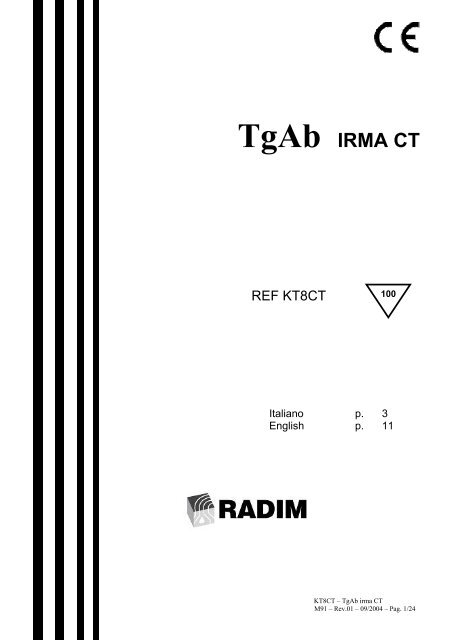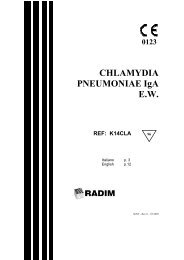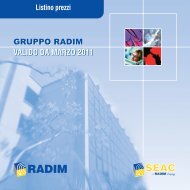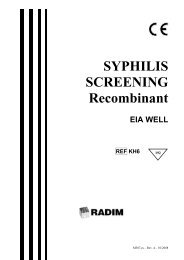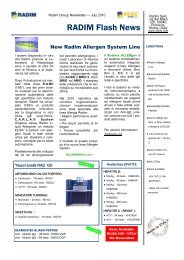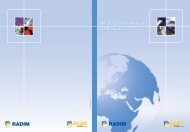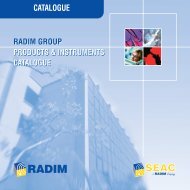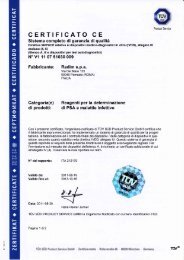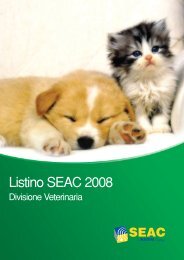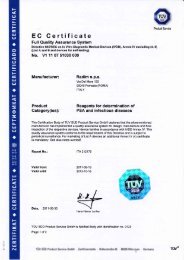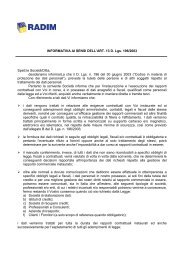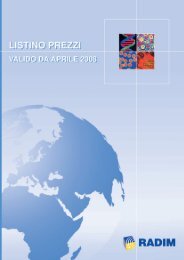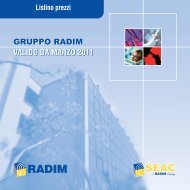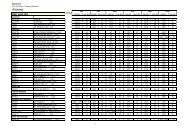You also want an ePaper? Increase the reach of your titles
YUMPU automatically turns print PDFs into web optimized ePapers that Google loves.
<strong>TgAb</strong> <strong>IRMA</strong> <strong>CT</strong><br />
REF KT8<strong>CT</strong><br />
100<br />
Italiano p. 3<br />
English p. 11<br />
KT8<strong>CT</strong> – <strong>TgAb</strong> irma <strong>CT</strong><br />
M91 – Rev.01 – 09/2004 – Pag. 1/24
Reagenti del Kit - Kit Reagents<br />
Reag. Quant, Stato fisico, Physical state<br />
<strong>CT</strong><br />
100 Pronte per l'uso, Ready for use.<br />
CAL<br />
6 x 1 mL Pronto per l'uso, Ready for use.<br />
CONJ I 125<br />
1 x 10 mL Pronto per l'uso, Ready for use.<br />
DIL<br />
<strong>CT</strong>R<br />
WASH<br />
1x15 ml Conc<br />
2 x 1 mL Pronto per l'uso, Ready for use.<br />
1 x 50 mL Conc<br />
KT8<strong>CT</strong> – <strong>TgAb</strong> irma <strong>CT</strong><br />
M91 – Rev.01 – 09/2004 – Pag. 2/24
DOSAGGIO IMMUNORADIOMETRICO PER LA DETERMINAZIONE<br />
QUANTITATIVA DEGLI AUTOANTICORPI ANTI-TIREOGLOBULINA (TGAB)<br />
NEL SIERO UMANO<br />
PER USO DIAGNOSTICO IN VITRO<br />
1. APPLICAZIONI CLINICHE<br />
Pazienti affetti da tireopatie anche molto diverse tra loro, come ipo ed<br />
ipertiroidismo (morbo di Hashimoto e morbo di Graves) presentano spesso nel<br />
siero autoanticorpi diretti contro l'antigene microsomiale (TMAB) e la<br />
tireoglobulina (TGAB). L'autoimmunità tiroidea è più frequente nelle donne. La<br />
concentrazione degli anticorpi nelle donne aumenta con l'età, dal 10 % (18-24<br />
anni) al 30 % (55-65 anni) per il TGAB e dal 15% (18-24 anni) al 24% (55-65 anni)<br />
per il TMAB. Elevate concentrazioni di TGAB possono condurre allo sviluppo di<br />
tireopatie croniche che si risolvono spesso in ipotiroidismi. Le tireopatie<br />
asintomatiche con ipertiroidismo transitorio sono frequenti come effetto postpartum.<br />
In soggetti che presentano gozzi moderati si è riscontrata un'elevata<br />
concentrazione di TMAB e/o anti-TPO. La valutazione di TGAB, TMAB e/o anti-<br />
TPO è stata recentemente proposta tra le indagini per le gravidanze a rischio. Nel<br />
mixedema idiopatico significativi livelli di TGAB e TMAB evidenziano lo stadio<br />
terminale di tireopatia autoimmune cronica atrofica. Nei pazienti in età giovanile<br />
un evidente gozzo associato a valori elevati di TGAB e TMAB è generalmente<br />
sintomo del morbo di Hashimoto, caratterizzato da una progressiva diminuzione<br />
delle funzioni tiroidee che porta fino all'ipotiroidismo. Nel morbo di Graves il gozzo<br />
tossico è associato a tiroiditi croniche, come confermato da alti livelli di TGAB e<br />
TMAB. Il monitoraggio del TGAB, TMAB ed anti-TPO è frequentemente usato<br />
durante la terapia. Il dosaggio del TGAB può dare informazioni sul rischio di<br />
trasmissione di malattie autoimmuni all’interno dello stesso nucleo familiare.<br />
2. PRINCIPIO DEL METODO<br />
II presente kit utilizza provette sensibilizzate con Tireoglobulina umana. Nella<br />
prima incubazione gli autoanticorpi presenti nei Calibratori e nei campioni in<br />
esame si legano all'antigene adeso alla fase solida. Dopo un lavaggio,si aggiunge<br />
il Coniugato Radioattivo (a-human IgG- 125 I) nelle provette. Il Coniugato durante<br />
l'incubazione si lega agli anticorpi precedentemente fissati. L'eccesso dei reagenti<br />
è rimosso per aspirazione e lavaggio. La radioattività residua nelle provette è<br />
misurata in un contatore di raggi gamma e sarà direttamente proporzionale alla<br />
quantità di autoanticorpi anti-Tireoglobulina presenti nel campione.<br />
KT8<strong>CT</strong> – <strong>TgAb</strong> irma <strong>CT</strong><br />
M91 – Rev.01 – 09/2004 – Pag. 3/24
3. REAGENTI CONTENUTI NEL KIT: PREPARAZIONE E STABILITA'<br />
− I reagenti sono sufficienti per 100 tubi.<br />
− Il kit deve essere conservato a 2-8°C.<br />
− La data di scadenza di ciascun reagente é indicata sulla rispettiva etichetta.<br />
<strong>CT</strong> Provette Sensibilizzate: 100 provette sensibilizzate con<br />
Tireoglobulina umana. Le provette non utilizzate devono essere<br />
riposte a 2-8°C nella loro custodia, accuratamente richiusa.<br />
CAL Calibratori: 1 flacone (1 ml) di Calibratore Zero e 6 flaconi (1 ml) di<br />
anticorpi anti-Tireoglobulina in matrice proteica alle seguenti<br />
concentrazioni: 0, 25, 50, 150 , 500 e 2000 IU/ml. Pronti per l'uso .<br />
Conservante: NaN3 (
MATERIALE RADIOATTIVO<br />
Radionuclide presente: I 125<br />
5. INFORMATIVA (D.Lgs. 230/95 – D.Lgs. 241/00 art. 19) E NORME DI<br />
SICUREZZA E PREVENZIONE<br />
Per ottenere risultati corretti e riproducibili, è necessario osservare le<br />
seguenti norme:<br />
− Non mescolare reagenti di lotti differenti.<br />
− Non usare i reagenti dopo la data di scadenza.<br />
− Non esporre i reattivi e i campioni a calore intenso o a forti sorgenti di<br />
inquinamento.<br />
− Usare vetreria perfettamente pulita ed esente da contaminazioni di ioni<br />
metallici o sostanze ossidanti.<br />
− Usare acqua distillata o deionizzata, conservata in recipienti perfettamente<br />
puliti.<br />
− Evitare accuratamente contaminazioni tra campioni; a tal fine è consigliabile<br />
usare pipette con puntali monouso per ogni campione e per ogni reattivo.<br />
− Non modificare in alcun modo il Procedimento Operativo di esecuzione del<br />
test. Eventuale non rispetto di:<br />
• sequenza e quantità nell’aggiunta dei reattivi<br />
• tempi e temperatura di incubazione<br />
può dare luogo a risultati clinici errati.<br />
− Ricostituire gli eventuali reagenti liofili secondo le modalità descritte sulle<br />
etichette. Eventuale utilizzo di reattivi o volumi non idonei, può provocare<br />
l’ottenimento di dati clinici non attendibili.<br />
− In caso di procedura manuale è importante l’utilizzo di pipette calibrate e<br />
possedere un’adeguata manualità tecnica. In particolare è essenziale una<br />
buona precisione nella preparazione e dispensazione dei reattivi. E’ necessario<br />
un adeguato piano di manutenzione (pulizia e calibrazione) di tale<br />
strumentazione.<br />
− Accertarsi che tutta la strumentazione usata (vetreria, bagno termostatato,<br />
agitatore e lavatore, contatore gamma, frigoriferi usati per la conservazione dei<br />
kit e dei campioni) sia perfettamente funzionante, adeguatamente calibrata e<br />
sia soggetta ad un regolare piano di manutenzione. Un uso non accurato di<br />
ognuno di questi strumenti può produrre errori metodologici che possono<br />
condizionare la riproducibilità e l’affidabilità dei risultati ottenuti.<br />
− Utilizzare un adeguato metodo per la corretta identificazione dei campioni.<br />
Possibili conseguenze possono essere sia la perdita di specificità del<br />
dispositivo che risultati analitici errati.<br />
Con lo scopo di ridurre i rischi di tipo fisico, biologico e chimico, è<br />
necessario osservare le seguenti norme di sicurezza:<br />
− Utilizzare dispositivi di protezione individuale (es.: guanti monouso, camice,<br />
ecc.) durante la manipolazione di materiale radioattivo e/o potenzialmente<br />
infetto e durante il dosaggio.<br />
KT8<strong>CT</strong> – <strong>TgAb</strong> irma <strong>CT</strong><br />
M91 – Rev.01 – 09/2004 – Pag. 5/24
− Non pipettare i reagenti con la bocca.<br />
− Non fumare, mangiare, bere o applicare cosmetici durante l'esecuzione del<br />
dosaggio.<br />
− La manipolazione di sostanze radioattive deve essere eseguita in aree<br />
specificamente predisposte.<br />
− Le sostanze radioattive devono essere conservate nei loro contenitori originali<br />
in un’area specificamente predisposta.<br />
− E’ necessario compilare un registro che indichi dettagliatamente l’ingresso, la<br />
conservazione e l’eliminazione di tutto il materiale radioattivo ricevuto.<br />
− E’ necessario eliminare immediatamente qualunque contaminazione<br />
radioattiva secondo le procedure stabilite.<br />
− I materiali di origine umana utilizzati nella preparazione del presente kit sono<br />
stati saggiati per la presenza di HBsAg, anti-HIV e anti-HCV e sono risultati<br />
ripetutamente negativi. Comunque nessun test attualmente disponibile<br />
garantisce l'assenza degli agenti virali responsabili della sindrome da<br />
immunodeficienza acquisita, dell'epatite B ed epatite C. Tutti i reagenti<br />
contenenti materiale biologico e tutti i campioni di siero umano devono essere<br />
considerati potenzialmente infettivi.<br />
− Evitare la produzione di schizzi e la formazione di aerosol; qualora ciò si<br />
verificasse ripulire accuratamente con ipoclorito di sodio ad una<br />
concentrazione del 3%. Il mezzo adoperato per la pulizia deve essere trattato<br />
come residuo potenzialmente infetto ed eliminato secondo le modalità<br />
opportune.<br />
− La sodio azide contenuta come conservante in alcuni reagenti, può reagire con<br />
il piombo ed il rame delle tubature formando azidi di metallo altamente<br />
esplosive. Per evitare la formazione e l'accumulo di tali composti far scorrere<br />
abbondante acqua sui reagenti eliminati.<br />
− I reagenti per cui non si fornisce la scheda di sicurezza non contengono<br />
sostanze chimiche pericolose o se presenti, queste sono al di sotto dei limiti di<br />
concentrazione definiti nel D.Lgs.285/98 e nella direttiva CEE 91/155.<br />
− Ai sensi del D.L. italiano n. 22 del 05.02.97, che fa riferimento alle direttive<br />
CEE (91/156/CEE, 91/689/CEE, 94/62/CEE) tutti i rifiuti provenienti da<br />
lavorazioni manuali e/o in automatico sono classificati rifiuti speciali pericolosi<br />
con codice di classificazione CER 180103 (rifiuti infetti o potenzialmente<br />
infetti); devono quindi essere eliminati affidandoli a ditte autorizzate al ritiro ed<br />
allo smaltimento.<br />
− Tutti i rifiuti provenienti da lavorazioni con radioisotopi devono essere smaltiti<br />
affidandoli a ditte autorizzate al ritiro in accordo a quanto previsto nel D.Lgs.<br />
241/2000.<br />
− L'acquisto, la detenzione, l'impiego e lo smaltimento di materiale radioattivo<br />
(sia solido che liquido) sono soggetti alle disposizioni locali previste dalle<br />
autorità legislative.<br />
La quantità di radioattività alla data di riferimento è specificata<br />
nell’etichetta esterna del kit.<br />
KT8<strong>CT</strong> – <strong>TgAb</strong> irma <strong>CT</strong><br />
M91 – Rev.01 – 09/2004 – Pag. 6/24
6. RACCOLTA E PREPARAZIONE DEI CAMPIONI<br />
Il dosaggio può essere effettuato su siero. I campioni fortemente lipemici od<br />
emolizzati devono essere scartati. I campioni possono essere conservati a 2-8°C<br />
per 1 giorno; per periodi più lunghi aliquotare e congelare a -20°C. Assicurarsi che<br />
i campioni siano perfettamente limpidi prima di dosarli. Si consiglia di non<br />
congelare e scongelare ripetutamente i campioni.<br />
Prediluizione del campione<br />
I campioni devono essere prediluiti 1:101 prima del dosaggio, come segue:<br />
10 Pl di Campioni + 1000 Pl di Diluente.<br />
Calibratori e Siero di Controllo sono già prediluiti e pronti per l'uso.<br />
NOTA: Nel caso in cui i campioni devono essere testati simultaneamente per<br />
TGAB e TPOAb (cat. KT15<strong>CT</strong>), è possibile effettuare un'unica prediluizione<br />
utilizzando lo stesso diluente dei campioni.<br />
7. PROCEDIMENTO OPERATIVO<br />
− Attendere che i reagenti ed i campioni raggiungano la temperatura ambiente.<br />
− Agitare i campioni per inversione prima dell'uso.<br />
7.1 Preparare le provette sensibilizzate per: Calibratori (0-5), i sieri di Controllo, i<br />
Campioni e provette non sensibilizzate per l'Attività Totale.<br />
7.2 Dispensare 100 El di ciascun Calibratore, dei Sieri di Controllo e dei<br />
Campioni prediluiti nelle rispettive provette.<br />
7.3 Agitare e coprire le provette con del parafilm o fogli di alluminio.<br />
7.4 Incubare per 2 ore a T.A. su agitatore orbitale (150 rpm)<br />
7.5 Al termine dell'incubazione aspirare accuratamente la miscela di<br />
incubazione da tutte le provette.<br />
7.6 Lavare le provette 2 volte con 1 ml di Soluzione di lavaggio<br />
opportunamente diluita. Aspirare completamente il liquido da tutte le<br />
provette oppure decantare asciugando il bordo delle provette su carta<br />
bibula.<br />
7.7 Dispensare 100 El di Coniugato Radioattivo in tutte le provette.<br />
7.8 Agitare e coprire le provette con del parafilm o fogli di alluminio.<br />
7.9 Incubare per 90 minuti a T.A. su agitatore orbitale (150 rpm) o O.N. a<br />
T.A.<br />
7.10 Aspirare accuratamente la miscela di incubazione da tutte le provette,<br />
eccetto quelle dell'attività totale.<br />
7.11 Lavare le provette 2 volte con 1 ml di Soluzione di lavaggio<br />
opportunamente diluita. Aspirare completamente il liquido da tutte le<br />
provette oppure decantare asciugando il bordo delle provette su carta<br />
bibula.<br />
KT8<strong>CT</strong> – <strong>TgAb</strong> irma <strong>CT</strong><br />
M91 – Rev.01 – 09/2004 – Pag. 7/24
7.12 Misurare la radioattività presente nelle provette in un contatore gamma per 1<br />
minuto. Si raccomanda di controllare il fondo dello strumento prima di<br />
effettuare il conteggio. Per non variare la sensibilità del sistema é<br />
necessario che il fondo sia ridotto al minimo oppure opportunamente<br />
corretto.<br />
8. SCHEMA DEL DOSAGGIO: vedi pag. 23<br />
9. CALCOLO DEI RISULTATI<br />
Calcolare le conte per minuto (cpm) dei conteggi relativi ai Calibratori ed ai<br />
campioni o le relative percentuali di legame.<br />
Cpm legati alla fase solida<br />
B/T % = ------------------------------------ x 100<br />
Cpm dell'attività totale<br />
Riportare i valori su una carta da grafico semi-log, ponendo in ascissa le<br />
concentrazioni dei Calibratori ed in ordinata le conte per minuto corrispondenti,<br />
oppure i rapporti (B/T) %. Il Calibratore Zero deve essere considerato come la<br />
prima concentrazione della curva di taratura. La lettura della dose dei campioni è<br />
effettuata mediante interpolazione dei rispettivi conteggi o percentuali di legame<br />
sulla curva di taratura.<br />
9.1 Esempio di Calcolo<br />
I valori sotto riportati devono essere considerati unicamente un esempio e non<br />
devono essere utilizzati in luogo dei dati sperimentali.<br />
Descrizione cpm B/T % TGAB<br />
Attività Totale (T) 149887<br />
Calibratore 0 IU/ml 359 0.24<br />
Calibratore 25 IU/ml 839 0.56<br />
Calibratore 50 IU/ml 1792 1.19<br />
Calibratore 150 IU/ml 5849 3.88<br />
Calibratore 500 IU/ml 19477 12.95<br />
Calibratore 2000 IU/ml 71217 47.31<br />
Controllo 1 3418 2.24 109 IU/ml<br />
Controllo 2 40697 26.75 880 IU/ml<br />
9.2 Valori Normali<br />
I valori riportati nella tabella seguente sono soltanto indicativi. Si raccomanda a<br />
ciascun laboratorio di stabilire i propri intervalli di riferimento.<br />
< 100 IU/ml: negativo per anticorpi anti-<br />
Tireoglobulina.<br />
> 120 IU/ml: positivo per anticorpi anti-<br />
Tireoglobulina.<br />
100-120 IU/ml Valori dubbi<br />
KT8<strong>CT</strong> – <strong>TgAb</strong> irma <strong>CT</strong><br />
M91 – Rev.01 – 09/2004 – Pag. 8/24
9.3 Criteri di accettazione<br />
Prima di procedere al calcolo dei risultati, verificare che la concentrazione del<br />
siero di controllo rientri nel range di accettazione descritto nel Foglio di Controllo<br />
Qualità.<br />
10. CARATTERISTICHE METODOLOGICHE<br />
10.1 Specificità<br />
Il presente metodo non ha mostrato reazioni crociate con autoanticorpi anti – TPO<br />
e/o con TPO.<br />
L’impiego di hTG altamente purificata per la produzione della fase solida riduce la<br />
possibilità di cross – reazioni con proteine aspecifiche.<br />
10.2 Sensibilità<br />
La sensibilità é stata calcolata sulla curva di calibrazione ed espressa come<br />
minima dose significativamente distinguibile dalla risposta del Calibratore Zero<br />
(valore medio + 2 D.S.). Tale dose é risultata pari a 2.0 IU/ml.<br />
10.3 Precisione<br />
La precisione é stata valutata misurando la ripetibilità e la riproducibilità (variabilità<br />
intra-saggio ed inter-saggio) su 3 sieri a differenti concentrazioni di TGAB.<br />
Ripetibilità (Intra-saggio)<br />
Siero Media ± D.S. C.V. Replicati<br />
(IU/ml) % n.<br />
a 24.15 ± 2.23 9.24 10<br />
b 146.36 ± 15.26 10.42 10<br />
c 423.32 ± 46.06 10.88 10<br />
Riproducibilità (Inter-saggio)<br />
Siero Media ± D.S. C.V. Dosaggi<br />
(IU/ml) % n.<br />
a 104.7 ± 13.8 13.14 10<br />
b 482.6 ± 62.3 12.91 10<br />
c 943.1 ± 80.3 8.52 10<br />
KT8<strong>CT</strong> – <strong>TgAb</strong> irma <strong>CT</strong><br />
M91 – Rev.01 – 09/2004 – Pag. 9/24
10.4 Accuratezza<br />
L'accuratezza del metodo é stata valutata mediante il test di recupero ed il test di<br />
parallelismo.<br />
Test di Parallelismo<br />
Un siero a medio contenuto di TGAb è stato dosato a varie diluizioni effettuate<br />
con il Diluente dei campioni.<br />
Diluizione Atteso<br />
(IU/mL)<br />
Misurato<br />
(IU/mL)<br />
S1 indiluito 225.99<br />
1: 2 112.99 86.1<br />
1: 4 56.49 54.42<br />
1: 8 28.24 20.72<br />
1: 16 14.12 12.91<br />
10.5 Effetto Saturazione<br />
L’effetto saturazione è stato verificato con sieri fortemente positivi i quali hanno<br />
evidenziato un B/T maggiore dell’ultimo punto della curva di calibrazione .<br />
Non si evidenzia effetto saturazione fino alla concentrazione U 3.000.000 IU/ml.<br />
11. LIMITI DEL DOSAGGIO<br />
I risultati del dosaggio devono essere interpretati con cautela e convalidati da<br />
valutazioni cliniche ed ulteriori prove diagnostiche<br />
12. LEGENDA SIMBOLI: vedi pag. 19<br />
KT8<strong>CT</strong> – <strong>TgAb</strong> irma <strong>CT</strong><br />
M91 – Rev.01 – 09/2004 – Pag. 10/24
IMMUNORADIOMETRIC ASSAY FOR THE QUANTITATIVE DETERMINATION<br />
OF ANTI-THYROGLOBULIN AUTOANTIBODIES (TGAB) IN HUMAN SERUM<br />
FOR IN VITRO DIAGNOSTIC USE ONLY<br />
1. CLINICAL APPLICATIONS<br />
Autoimmune thyroid diseases encompass a wide spectrum of different clinical<br />
symptoms varying from hypo- to hyperthyroidism (Hashimoto's disease and<br />
Graves' disease). The link between these extremes is the presence of serum<br />
auto-antibodies directed against the microsomal antigen (TMAB) and/or<br />
thyroglobulin (TGAB). Thyroid autoimmunity is more frequently registered in<br />
women. Antibody prevalence in women increases with age, rising from<br />
approximately 10% at the age of 18-24 up to 30% at the age of 55-65 for TGAB<br />
and from 15% at the age of 18-24 up to 24% at the age of 55-65 for TMAB. These<br />
significant TGAB and TMAB titers can lead to the development of chronic<br />
thyroiditis, often resulting in hypothyroidism. Asymptomatic thyroid diseases with<br />
transient hyperthyroidism have been frequently noted in post-partum conditions.<br />
Subjects with moderate-sized goiters exhibit high TMAB and/or anti-TPO levels. A<br />
rise in TGAB, TMAB and/or anti-TPO has recently been proposed as an<br />
independent marker for at "at-risk" pregnancies. In cases of primary myxoedema,<br />
significant TGAB and TMAB levels indicate the end-stage of autoimmune atrophic<br />
chronic thyroiditis. In younger patients, a firm goiter found in combination with high<br />
TGAB and TMAB levels is generally a sign of Hashimoto's disease, characterized<br />
by a progressive decrease in thyroid function leading to hypothyroidism. In<br />
Graves' disease, the toxic goiter is associated to chronic thyroiditis, as confirmed<br />
by high TGAB and TMAB levels. Monitoring of TGAB, TMAB and anti-TPO levels<br />
is frequently used for treatment follow-up. TGAB can also be used as a marker for<br />
identification of family members exposed to the risk of transmission of<br />
autoimmune conditions.<br />
2. PRINCIPLE OF THE ASSAY<br />
This test uses tubes coated with human thyroglobulin. During the first incubation<br />
the autoantibodies possibly present in Calibrators and samples are bound to the<br />
antigen coated on the solid phase. After washing to remove all unbound material,<br />
125 I labelled a-human Igg is bound to the antibodies captured in the first step. The<br />
excess Conjugate is removed by aspiration and washing. The radioactivity of the<br />
Conjugate bound to the solid phase is measured in a gamma counter and is<br />
directly proportional to anti-Thyroglobulin autoantibodies (TGAB) concentration in<br />
samples.<br />
KT8<strong>CT</strong> – <strong>TgAb</strong> irma <strong>CT</strong><br />
M91 – Rev.01 – 09/2004 – Pag. 11/24
3. REAGENTS PROVIDED WITH THE KIT: PREPARATION AND STABILITY<br />
− The reagents are sufficient for 100 tubes.<br />
− Store the kit at 2-8°C.<br />
− The expiry date of each reagent is shown on the vial label.<br />
<strong>CT</strong> Coated Tubes: 100 tubes coated with human Thyroglobulin. Unused<br />
tubes should be placed at 2-8°C in the appropriate bag and carefully<br />
sealed.<br />
CAL Calibrators: 1 vial (1 ml) of Zero Calibrator and 6 vials (1 ml) of anti-<br />
Thyroglobulin antibodies in serum matrix, at the following<br />
concentrations: 0, 25, 50, 150, 500 and 2000 IU/ml. Ready for use and<br />
. Preservative: NaN3 (
RADIOA<strong>CT</strong>IVE MATERIAL<br />
Radionuclide: 125 I<br />
5. ITALIAN DECREES (D.Lgs. 230/95 – D.Lgs. 241/00 art. 19) AND RULES OF<br />
PREVENTION AND SECURITY<br />
In order to obtain correct and reproducible results, the following rules must<br />
be observed:<br />
− Do not mix reagents of different lots.<br />
− Do not use reagents beyond their expiry date.<br />
− Do not store or leave reagents and samples at high temperatures or areas of<br />
possible contamination.<br />
− Use thoroughly clean glassware, free from metal ion contamination or oxidizing<br />
substances.<br />
− Use distilled or deionized water, stored in perfectly clean containers.<br />
− Carefully avoid any contamination among samples; for this purpose,<br />
disposable tips should be used for each sample and reagent.<br />
− Do not modify in any way the "Assay Procedure". If you not respect:<br />
• exact incubation times and quantities adding the reagents<br />
• incubation times and temperature<br />
may cause incorrect clinical results.<br />
− Reconstitute lyophilized reagents, if present, as described on the relative<br />
labels. Any deviation in reagent use or wrong volumes, may affect the reliability<br />
of results obtained.<br />
− In case of manual procedure, it is important to use calibrated pipettes and have<br />
appropriate technical manuals. Primary importance is a good precision<br />
preparing and dispensing the reagents. Ensure that all the equipment used is<br />
in perfect working order, has been correctly calibrated and is regularly<br />
maintained.<br />
− Ensure that all the equipment used (glassware, incubators, shakers, tube<br />
washers, gamma counter and fridge/freezers used for reagent and sample<br />
storage) is in perfect working order, has been correctly calibrated and is<br />
regularly maintained. Any deviation from the correct use of the equipment<br />
listed can produce errors in the methodology, this may affect the reproducibility<br />
and reliability of results obtained.<br />
− Utilise a suitable method for the correct identification of patient samples.<br />
Incorrect identification may cause a specificity losses of the system and wrong<br />
clinical results.<br />
In order to reduce physical, biological and chemical risks, the following<br />
precautions must be observed:<br />
− Use protective individual articles (ex.: disposable gloves, lab coats, etc.) while<br />
handling radioactive materials and/or potentially infectious material as well as<br />
during the assay.<br />
− Do not pipette reagents by mouth.<br />
KT8<strong>CT</strong> – <strong>TgAb</strong> irma <strong>CT</strong><br />
M91 – Rev.01 – 09/2004 – Pag. 13/24
− Do not smoke, eat, drink or apply cosmetics during the assay.<br />
− All radiological work should be done in a designated area.<br />
− Radioactive materials should be stored in their original container in a<br />
designated area.<br />
− A record book for logging receipt and disposal of all radioactive materials<br />
should be kept.<br />
− Any radioactive spills should be taken care of immediately in accordance with<br />
established procedures.<br />
− All material of human origin used for the preparation of this kit was tested<br />
negative for HBsAg, anti-HIV and anti-HCV. Since no test at present can<br />
guarantee complete absence of these viruses, all samples and reagents<br />
containing biological material used for the assay must be considered<br />
potentially infectious.<br />
− Avoid splashing and aerosol formation; in such cases, carefully wash with a<br />
3% sodium hypochlorite solution. Any cleaning material used for that purpose<br />
must be treated as potentially infectious and disposed accordingly.<br />
− The sodium azide used as preservative in some reagents may react with lead<br />
and copper plumbing; to prevent build-up of explosive metal azides, the<br />
reagents should be discarded by flushing the drain with large amounts of<br />
water.<br />
− The reagents for which a Safety Data Sheet is not supplied do not contain<br />
hazardous chemical substances or, if they do, these are below the<br />
concentration limits established by the Italian decree D.Lgs.285/98 in<br />
compliance with EEC directive 91/155.<br />
− According to Italian decree D.L. no. 22 dated 05.02.97, in compliance with EEC<br />
directives (91/156/EEC, 91/689/EEC, 94/62/EEC), all waste products<br />
originating from either manual and/or automated processing are classified as<br />
hazardous special waste material (European classification code 180103,<br />
infectious waste or potentially infectious waste). As such, they must be<br />
eliminated (by) delegating them to special enterprises (companies), qualified<br />
for waste collection and disposal.<br />
− All radioactive waste originating from either manual and/or automated<br />
processing, must be eliminated delegating them to special enterprises,<br />
qualified for waste collection and disposal, according to D.Lgs.241/2000.<br />
− Acquisition, storage, use and disposal of radioactive material (liquid and solid)<br />
are subjected to regulation and ordination of local authorities.<br />
Radioactivity contents to the reference date is shown on the kit external<br />
label.<br />
6. SPECIMEN COLLE<strong>CT</strong>ION AND PREPARATION<br />
The assay can be performed in serum. Highly lipemic or hemolyzed samples must<br />
be discarded. Keep samples at 2-8°C for 1 day; for longer periods it is advisable<br />
to freeze samples in aliquots at -20°C. Make sure that samples are always<br />
KT8<strong>CT</strong> – <strong>TgAb</strong> irma <strong>CT</strong><br />
M91 – Rev.01 – 09/2004 – Pag. 14/24
perfectly clear before testing. Repeated freezing and thawing of samples should<br />
be avoided.<br />
Sample pre-dilution<br />
Before testing, samples must be diluted 1:101 as follows:<br />
10 Pl Sample + 1000 Pl Diluent<br />
Calibrators and Control Serum are already prediluted and ready for use.<br />
NOTE: when serum samples are to be tested simultaneously for TGAB and<br />
TPOAb (cat. KT15<strong>CT</strong>) a unique pre-dilution for both assays can be made, by<br />
using the same Diluent.<br />
7. ASSAY PROCEDURE<br />
− Allow reagents and samples to warm up at room temperature.<br />
− Mix samples by inversion before use.<br />
7.1 Prepare coated tubes for: Calibrators (0-5), Control Serum and Samples.<br />
Uncoated test tubes may be used for Total Activity.<br />
7.2 Pipette 100 El of each Calibrator, Control Serum and prediluted Sample into<br />
the corresponding tubes.<br />
7.3 Vortex and cover the tubes with parafilm or aluminum foil.<br />
7.4 Incubate for 2 hours at T.A. (150 rpm)<br />
7.5 At the end of the incubation, carefully aspirate the incubation mixture from<br />
all tubes.<br />
7.6 Wash the tubes twice with 1 ml of diluted Washing Solution. Aspirate all<br />
liquid from the tubes or decant by drying the edges of the tubes with blotpaper.<br />
7.7 Add 100 El of Radioactive Conjugate into all tubes.<br />
7.8 Vortex and cover the tubes with parafilm or aluminum foil.<br />
7.9 Incubate for 90 minutes at T.A. (150rpm) or O.N. at T.A.<br />
7.10 Carefully aspirate the incubation mixture from all tubes, except for the Total<br />
Activity tube.<br />
7.11 Wash the tubes twice with 1 ml of diluted Washing Solution. Aspirate all<br />
liquid from the tubes or decant by drying the edges of the tubes with blotpaper.<br />
7.12 Count the radioactivity in the tubes for 1 minute by using a gamma counter.<br />
We suggest to check the background of the instrument before counting the<br />
assay. In order to avoid variations in the sensitivity of the system, the<br />
background should be reduced to a minimum or adjusted properly.<br />
8. ASSAY SCHEME: see pag. 23<br />
KT8<strong>CT</strong> – <strong>TgAb</strong> irma <strong>CT</strong><br />
M91 – Rev.01 – 09/2004 – Pag. 15/24
9. CALCULATION OF RESULTS<br />
Calculate Calibrator and Sample counts per minute (cpm) or their percent binding:<br />
Solid phase cpm<br />
B/T % = ------------------------- x 100<br />
Total activity cpm<br />
Draw a calibration curve on semi-log graph paper by plotting the cpm or percent<br />
binding (B/T)% of each Calibrator (y-axis) against the relative concentration (xaxis).<br />
Consider the Zero Calibrator as the first concentration of the calibration<br />
curve. Read the sample concentration by interpolatig the counts or percent<br />
binding on the calibration curve.<br />
9.1 Example of Calculation<br />
The values shown below must be considered as an example and must not be<br />
used in place of experimental data.<br />
Description cpm B/T % TGAB<br />
Total Activity (T) 149887<br />
Calibrator 0 IU/ml 359 0.24<br />
Calibrator 25 IU/ml 839 0.56<br />
Calibrator 50 IU/ml 1792 1.19<br />
Calibrator 150 IU/ml 5849 3.88<br />
Calibrator 500 IU/ml 19477 12.95<br />
Calibrator 2000 IU/ml 71217 47.31<br />
Control 1 3418 2.24 109 IU/ml<br />
Control 2 40697 26.75 880 IU/ml<br />
9.2 Normal Values<br />
The values reported below are indicative. We suggest that each laboratory<br />
establishes its own normal range.<br />
Lower than 100 IU/ml: negative for anti-Thyroglobulin antibodies.<br />
Higher than 120 IU/ml: positive for anti-Thyroglobulin antibodies.<br />
100-120 IU/ml Bordeline values<br />
KT8<strong>CT</strong> – <strong>TgAb</strong> irma <strong>CT</strong><br />
M91 – Rev.01 – 09/2004 – Pag. 16/24
9.3 Validation Criteria<br />
Before proceeding to calculation of results, make sure the control serum<br />
concentration is included within the value described on the Quality Control Sheet.<br />
10. PERFORMANCES OF THE ASSAY<br />
10.1 Specificity<br />
No cross-reactions have been observed with human Thyroperoxidase<br />
autoantibodies and with human Thyroperoxidase.<br />
10.2 Sensitivity<br />
The sensitivity was calculated based upon the calibration curve and expressed as<br />
the minimal dose showing a significant difference from the Zero Calibrator (mean<br />
value + 2 S.D.). This dose is 2 IU/ml.<br />
10.3 Precision<br />
Precision was evaluated determining the repeatability and the reproducibility of<br />
the assay (intra- and inter-assay variability), on 3 sera at different TGAB<br />
concentrations.<br />
Repeatability (Intra-assay)<br />
Serum Mean ± S.D. C.V. Replicates<br />
(IU/ml) % n.<br />
a 24.15 ± 2.23 9.24 10<br />
b 146.36 ± 15.26 10.42 10<br />
c 423.32 ± 46.06 10.88 10<br />
Reproducibility (Inter-assay)<br />
Serum Mean ± S.D. C.V. Assays<br />
(IU/ml) % n.<br />
a 104.7 ± 13.8 13.14 10<br />
b 482.6 ± 62.3 12.91 10<br />
c 943.1 ± 80.3 8.52 10<br />
KT8<strong>CT</strong> – <strong>TgAb</strong> irma <strong>CT</strong><br />
M91 – Rev.01 – 09/2004 – Pag. 17/24
10.4 Accuracy<br />
Accuracy of the method has been checked by parallelism test.<br />
Parallelism test<br />
A medium TGAb concentration serum was tested at different dilutions with the<br />
Diluent sample.<br />
Dilution Expected<br />
Measured<br />
(IU/mL)<br />
(IU/mL)<br />
S1 undiluted 225.99<br />
1: 2 112.99 86.1<br />
1: 4 56.49 54.42<br />
1: 8 28.24 20.72<br />
1: 16 14.12 12.91<br />
10.5 High-dose Effect<br />
High-dose effect was verified with samples containing high antibody<br />
concentrations .<br />
Concentrations of IgG to Tg ≤ 3.000.000 IU/ml were observed with B/T higher<br />
than last calibrator concentration .<br />
11. LIMITS OF THE ASSAY<br />
The results of the assay must be carefully interpreted and confirmed by clinical<br />
evaluations and further diagnostic tests.<br />
12. SYMBOLS LEGEND: see pag. 19<br />
KT8<strong>CT</strong> – <strong>TgAb</strong> irma <strong>CT</strong><br />
M91 – Rev.01 – 09/2004 – Pag. 18/24
12. SIMBOLI, SYMBOLS, SYMBOLES, SÍMBOLOS, SÍMBOLOS, SYMBOLE,<br />
OPQRSTU, SYMBOLIT, SYMBOLER<br />
EN 980 - EDMA<br />
REF codice di riferimento o di ordine / reference or order code /<br />
Référence ou numéro de commande / referencia o número de<br />
pedido / referência ou número da encomenda / Referenz oder<br />
Bestellnummer / Z[\]Z^_ `abc^deb_ f `gaghhijkg_ / Refarans<br />
veye siparil numarsm / referennní nebo objednací níslo<br />
LOT Lotto / lot / Lot / lote / lote / charge / `gaek\g / parti / šarqe<br />
Data di scadenza / expiry date / date d’expiration / Fecha de<br />
caducidad / Data de vencimento / Verfallsdatum / rPiabPsdkg<br />
jfts_ / Son kullanma targhi / datum expirace<br />
IVD Per uso diagnostico in-vitro / For in-vitro diagnostic use / Pour<br />
diagnostic in-vitro / Para uso diagnóstico In-vitro / aplicação do<br />
diagnóstico In-vitro / Für den Gebrauch in der IN-VITRO-<br />
DIAGNOSTIK / h]g in vitro \]ghd[ye]Zf zafys / in –vitro<br />
diagnostik kullanmm / pro pouqití in-vitro<br />
Marcatura CE secondo le direttive IVD 98/79 CE / CE marking<br />
according to IVD guidelines 98/79 EC / marquage CE conforme<br />
aux directives IVD 98/79 EC / marcado CE según directiva de<br />
IVD 98/79 CE / marcação-CE segundo a directriz-IVD 98/79 /<br />
CE-Markierung bei Erfüllung der IVD Richtlinie 98/79 EG /<br />
{sPgdys CE |}yi] Zb]dbe]Zf_ b\shkg_ IVD 98/79 EC / 98/79 EC<br />
IVD tüzü~üne göre CE ilareti / CE oznanení dle IVD 98/79 EU<br />
Conservare a 2-8°C / keep at 2-8°C / conserver à 2-8°C /<br />
Conservar a 2-8°C / conservar a 2-8°C / Lagerung bei 2-8°C /<br />
ÄÅjgts yebÇ_ 2-8°C / 2-8°C da saklaymnmz / skladovat pÉi 2-8°C<br />
Fabbricante / Manufacturer / Fabriquant / produzido por /<br />
Fabricante / produkt der / ZgegyZiÇ}Ñieg] g`^ / tarafmndan<br />
üretilmiltir / výrobce<br />
Rischio biologico / Biohazard / Risque Biologique / Riesgo<br />
Biológico / Risco Biológico / B]bjbh]Z^_ Zkd\Çdb_ /<br />
………………….<br />
KT8<strong>CT</strong> – <strong>TgAb</strong> irma <strong>CT</strong><br />
M91 – Rev.01 – 09/2004 – Pag. 19/24
100<br />
Consultare la metodica operativa / consult instructions for use /<br />
consulter le mode opératoire / consultar las instrucciones de<br />
uso / consultar as instruções de uso / Schauen Sie die<br />
Arbeitsanleitung an / yǵ|bÇjiÇeikei e]_ b\shki_ zafys_ /<br />
kullanmmda balvurulacak bilgiler / Sledujte návod k pouqití<br />
Sufficiente per 100 test / sufficient for 100 tests / suffisant pour<br />
100 déterminations / suficiente para 100 determinaciones /<br />
Componentes para 100 testes / genügend für 100 Tests /<br />
i`gaZik h]g 100 eiye / 100 test için yeterli / dostanující pro 100<br />
testä<br />
RDATE Data di Riferimento / Reference date / Date de référence /<br />
Fecha de referencia / Data de refêrencia / Referenzdatum /<br />
sµiabµsdkg |gãµbd^µsys_ / Referans Targhi / referennní<br />
datum<br />
RCNS Ricostituire con / reconstitute with / reconstituer avec /<br />
reconstituir con / reconstituir com / rekonstituiren mit /<br />
gdgyÇye}eg] µi / ile karmltmrma / rekonstituovat s<br />
H2O Acqua distillata o deionizzata / deionized or distilled water / eau<br />
deionisée ou distillée / agua destilada o desionizada / água<br />
destilada ou deionizada / Deionisiertes oder Destilliertes<br />
Wasser / g`]bd]yµådb -g`iyeghµådb dia^ / deiyonize veya<br />
distile su / deionizovaná nebo destilovaná voda<br />
KT8<strong>CT</strong> – <strong>TgAb</strong> irma <strong>CT</strong><br />
M91 – Rev.01 – 09/2004 – Pag. 20/24
BIBLIOGRAFIA – REFERENCES<br />
1. Prentice L.M. et al. Geographical distribution of subclinical autoimmune<br />
thyroid disease in Britain: A study using highly sensitive direct assays for<br />
autoantibodies to thyroglobulin and thyroid peroxidase. Acta Endocrinologica,<br />
1990, 123, 493-8.<br />
2. Gauna A. et al. Immunological aspects of Graves' disease patients in different<br />
clinical stages. J. Endocrinol. Invest., 1989,12, 671-7.<br />
3. Stagnaro-Green A. et al. Detection of at-risk pregnancy by means of highly<br />
sensitive assays for thyroid autoantibodies. JAMA, 1990, 264, 1422-5.<br />
4. Walfish P.G., Farid N.R. The immunogenetic basis of autoimmune thyroid<br />
disease in "Autoimmunity and the Thyroid" (Walfish P.G., Wall J.R. and Volpe<br />
R. Editors), Academic Press, New York, 1984, 3-36.<br />
5. Bogner U. et al. Cytotoxicity in Hashimoto's thyroiditis in "Autoimmunity and<br />
the Thyroid" (Walfish P.G., Wall J.R. and Volpe R. Editors), Academic Press,<br />
New York, 1984, 347-8.<br />
6. Cox C. et al. Dosaggio sierico degli autoanticorpi anti-Tireoglobulina e anti-<br />
antigeni Microsomiali. Ligand Quarterly, 1989, 8, 598-603.<br />
7. Larsen P.R. Triiodothyronine: review of recent studies of its physiology and<br />
pathophysiology in man. Metabolism 1972 Nov. Vol: 21 (11), p: 1073-92.<br />
8. Brown.J. Chopra I.J. Cornell J.S et al. Thyroid physiology in health and<br />
disease ANNINTERNMED, 1974, 81/1 (68-81).<br />
9. Singer P.A., Nicoloff J.T., Estimation of the triiodothyronine secretion rate in<br />
euthyroid man. J. Clin. Endocr. Metab. 1972 Jan. Vol: 35 (1), p. 82 - 9.<br />
10. Surks M.I. Schadlow A.R. Stock J.M. Oppenheimer J.H. Determination of<br />
iodothyronine absorption and conversion of L-thyroxine (T4) to L-<br />
triiodothyronine (T3) using turnover rate techniques. J.Clin.Invest 1973 Apr.<br />
Vol: 52 (4), p: 805-11.<br />
KT8<strong>CT</strong> – <strong>TgAb</strong> irma <strong>CT</strong><br />
M91 – Rev.01 – 09/2004 – Pag. 21/24
11. Fleischer N. Burgus R. Vale W. Dunn T. Guillemin R. Preliminary<br />
observations on the effect of synthetic thyrotropin releasing factor on plasma<br />
thyrotropin levels in man. J.Clin.Endocrinol.Metab. 1970 Jul, Vol: 31 (1), p:<br />
109-12<br />
12. Sterling K. Refetoff S. Selenkow H.A. T3 thyrotoxicosis, Thyrotoxicosis due to<br />
elevated serum triiodothyronine levels. Jama 1970 Jul 27, Vol: 213 (4), p:<br />
571-5.<br />
13. Hollander C.S. and Shenkman L., in B. Rothfeld ed, "Nuclear Medicine in<br />
Vitro" (Philadelphia: Lippincott, 1974).<br />
14. Ekins, R. : Measurements of free hormones in blood. Endocrine Reviews,<br />
1990, 11 (1), 5-46.<br />
15. Maberly G., Waite K., MA G., Soni N., and Eastman C. Binding characteristics<br />
of Thyroxin Binding Globulin in serum of normal, pregnant and severely III<br />
euthytoid patients. Clin. Chem. 1986, 32 (4), 616-20.<br />
16. Midgley J. E. M. Direct and indirect free thyroxine assay methods: theory and<br />
practice. Clin. Chem. 2001, 47 (8), 1353-1363.<br />
KT8<strong>CT</strong> – <strong>TgAb</strong> irma <strong>CT</strong><br />
M91 – Rev.01 – 09/2004 – Pag. 22/24
SCHEMA DEL DOSAGGIO, ASSAY SCHEME<br />
Prediluizione del Campione, Sample predilution: 1/101<br />
Provette<br />
Tubes<br />
A.Tot<br />
Tot Act<br />
(T)<br />
CAL<br />
(0-5)<br />
<strong>CT</strong>R Campioni,<br />
Samples<br />
Reag.<br />
CAL (0 - 5) ---- 100 Pl ---- ----<br />
<strong>CT</strong>R 1 ---- ---- 100 Pl ----<br />
<strong>CT</strong>R 2 ---- ---- 100 Pl ----<br />
Sample 100 Pl<br />
− Agitare e incubare, Mix and incubate: 2h T.A. su agitatore orbitale (150 rpm).<br />
− Aspirare e lavare, Aspirate and wash: 2 x 1 ml.<br />
CONJ 100 Pl 100 Pl 100 Pl 100 Pl<br />
− Agitare e incubare / Mix and incubate<br />
A: 90 minuti T.A./R.T. (150 rpm-U/min)<br />
O, or<br />
B: 18-24 h. a T.A./R.T.<br />
− Aspirare e lavare, Aspirate and wash: 2 x 1 ml.<br />
− Leggere, Read.<br />
KT8<strong>CT</strong> – <strong>TgAb</strong> irma <strong>CT</strong><br />
M91 – Rev.01 – 09/2004 – Pag. 23/24
RADIM S.p.A. - Via del Mare, 125 - 00040 Pomezia (Roma) Italia – Tel.: 0039/06/91249.1 - Fax:<br />
0039/06/91249.443; National Order Entry: 0039/06/91249.702; Export Dept.:<br />
0039/06/91249.701; Customer Care: 0039/06/91249.700; www.radim.it<br />
KT8<strong>CT</strong> – <strong>TgAb</strong> irma <strong>CT</strong><br />
M91 – Rev.01 – 09/2004 – Pag. 24/24


